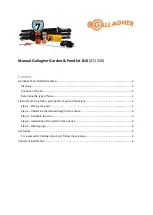
Glossary
63
Copyright © 2006–2022 Pico Technology Ltd. All rights reserved.
ps2000pg.en-12
PicoScope 2000 Series Programmer's Guide
8
Glossary
Aggregation.
, the PicoScope 2000 driver can use a method called
aggregation to reduce the amount of data your application needs to process. This means that
for every block of consecutive samples, it stores only the minimum and maximum values. You
can set the number of samples in each block, called the aggregation parameter, when you call
for real-time capture, and when you call
to obtain post-processed data.
Analog bandwidth.
The input frequency at which the signal amplitude has fallen by 3 dB, or by
half the power, from its nominal value.
Block mode.
A sampling mode in which the computer prompts the oscilloscope to collect a
block of data into its internal memory before stopping the oscilloscope and transferring the
whole block into computer memory. This is the best mode to use when the input signal being
sampled contains high frequencies. To avoid aliasing effects, the sampling rate must be greater
than twice the maximum frequency in the input signal.
Buffer size.
The size of the oscilloscope's buffer memory. The oscilloscope uses this to store
data temporarily so that it can sample data independently of the speed at which it can transfer
data to the computer.
Coupling mode.
This mode selects either AC or DC coupling in the oscilloscope's input path.
Use AC mode for small signals that may be superimposed on a DC level. Use DC mode for
measuring absolute voltage levels. Set the coupling mode using
Driver.
A piece of software that controls a hardware device. The driver for the PicoScope
2000 Series PC Oscilloscopes is supplied in the form of a 32-bit Windows
, which contains
that you can call from your application.
ETS.
Equivalent time sampling. Some PicoScope 2000 Series oscilloscopes can collect data
over a number of cycles of a repetitive waveform to give a higher effective sampling rate than
is possible for a single cycle. Equivalent time sampling allows the oscilloscope to use faster
timebases than those available in real-time mode.
Maximum sampling rate.
A figure indicating the maximum number of samples the
oscilloscope is capable of acquiring per second. Maximum sample rates are usually given in
MS/s (megasamples per second) or GS/s (gigasamples per second). The higher the sampling
speed of the oscilloscope, the more accurate the representation of the high-frequency details
in a fast signal.
Oversampling.
A method of increasing the effective resolution of a measurement by sampling
faster than the required sampling rate, then averaging the extra samples. An oversampling
factor of four increases the effective resolution by one bit, but this increased resolution comes
at the expense of reducing the maximum sampling rate by the same factor.
Overview buffer.
A buffer in the PC's memory in which the PicoScope 2000 Series driver
temporarily stores data on its way from the oscilloscope to the application's buffer.
PC Oscilloscope.
A virtual instrument consisting of a PicoScope PC Oscilloscope and a
software application.
PicoScope 2000 Series.
A range of low-cost PC Oscilloscopes that includes the PicoScope
2202, 2203, 2204 and 2205 two-channel oscilloscopes and the PicoScope 2104 and 2105
handheld oscilloscopes.
Summary of Contents for PicoScope 2000 Series
Page 1: ...Programmer s Guide ps2000pg en 12 PC Oscilloscopes PicoScope 2000 Series ...
Page 2: ......
Page 67: ......






































